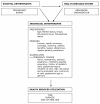Determinants of the number of antenatal visits in a metropolitan region
- PMID: 20809951
- PMCID: PMC2939647
- DOI: 10.1186/1471-2458-10-527
Determinants of the number of antenatal visits in a metropolitan region
Abstract
Background: Antenatal care has a positive effect on pregnancy, both clinically and psychologically, but consensus about the optimal number of antenatal visits is lacking. This study aims to provide insight into the dynamics of the number of antenatal visits a woman receives. Independent effects of predisposing, enabling and pregnancy-related determinants are examined.
Methods: Women were recruited in nine clinical centres in the Brussels Metropolitan region. Antenatal care use was measured prospectively. A Poisson regression model was applied to measure the independent effect of individual determinants on the number of antenatal visits.
Results: Data on antenatal care trajectories in 333 women were collected. The multivariate analyses showed that women with a Maghreb or Turkish origin had 14% fewer visits compared with European (EU15) women. More highly educated women had 22% more visits compared with those with a low education. Women with a high income had 14% more antenatal visits compared with those with a low income. Fewer antenatal visits were observed in multiparae (15%), women initiating care after 14 weeks of gestation (31%), women without medical risks during the pregnancy (12%) and in women with a continuity of care index of 50% or more (12%). More visits were observed in delivering after week 37 (22% increase).
Conclusions: Predisposing and enabling factors have to be considered when antenatal care programmes are evaluated in a metropolitan area. Variations in the number of antenatal visits show that socially vulnerable women are more at risk of having fewer visits.
Figures
Similar articles
-
Antenatal care use in urban areas in two European countries: Predisposing, enabling and pregnancy-related determinants in Belgium and the Netherlands.BMC Health Serv Res. 2016 Aug 2;16(a):337. doi: 10.1186/s12913-016-1478-3. BMC Health Serv Res. 2016. PMID: 27485241 Free PMC article.
-
Content and timing of antenatal care: predisposing, enabling and pregnancy-related determinants of antenatal care trajectories.Eur J Public Health. 2013 Feb;23(1):67-73. doi: 10.1093/eurpub/cks020. Epub 2012 May 23. Eur J Public Health. 2013. PMID: 22628457
-
Clinical, provider and sociodemographic determinants of the number of antenatal visits in England and Wales.Soc Sci Med. 2001 Apr;52(7):1123-34. doi: 10.1016/s0277-9536(00)00212-4. Soc Sci Med. 2001. PMID: 11266054
-
The pattern of antenatal visits with emphasis on gestational age at booking in Riyadh Health Centres.J R Soc Health. 1994 Apr;114(2):62-6. doi: 10.1177/146642409411400203. J R Soc Health. 1994. PMID: 8021892
-
Determinants of antenatal care utilisation in sub-Saharan Africa: a systematic review.BMJ Open. 2019 Oct 7;9(10):e031890. doi: 10.1136/bmjopen-2019-031890. BMJ Open. 2019. PMID: 31594900 Free PMC article.
Cited by
-
The adequacy of antenatal care services among slum residents in Addis Ababa, Ethiopia.BMC Pregnancy Childbirth. 2016 Jun 15;16(1):142. doi: 10.1186/s12884-016-0930-z. BMC Pregnancy Childbirth. 2016. PMID: 27306253 Free PMC article.
-
Utilisation of supplementary prenatal screening and diagnostics in Germany: cross-sectional study using data from the KUNO Kids Health Study.BMC Pregnancy Childbirth. 2022 May 24;22(1):436. doi: 10.1186/s12884-022-04692-1. BMC Pregnancy Childbirth. 2022. PMID: 35610584 Free PMC article.
-
Quality of antenatal care and associated factors among pregnant women in East Africa using Demographic and Health Surveys: A multilevel analysis.Womens Health (Lond). 2022 Jan-Dec;18:17455065221076731. doi: 10.1177/17455065221076731. Womens Health (Lond). 2022. PMID: 35114855 Free PMC article.
-
Continuity of care among diabetic patients in Accra, Ghana.Front Public Health. 2023 May 9;11:1141080. doi: 10.3389/fpubh.2023.1141080. eCollection 2023. Front Public Health. 2023. PMID: 37228731 Free PMC article.
-
Antenatal care use in urban areas in two European countries: Predisposing, enabling and pregnancy-related determinants in Belgium and the Netherlands.BMC Health Serv Res. 2016 Aug 2;16(a):337. doi: 10.1186/s12913-016-1478-3. BMC Health Serv Res. 2016. PMID: 27485241 Free PMC article.
References
-
- World Health Organization. Provision of effective antenatal care. 2006. http://who.int/reproductive-health/publications/standards/effective_ante... 26-11-2008.
-
- World Health Organization. Report of a Technical Working Group. Antenatal Care. 1996. http://who.int/reproductive-health/publications/maternal_newborn.en.htm 26-11-2008.
-
- World Health Organization. WHO Antenatal Care Randomized Trial: Manual for the Implementation of the New Model. 2001. http://who.int/reproductive-health/publications/RHR_01_30/index.html 26-11-2008.
Publication types
MeSH terms
LinkOut - more resources
Full Text Sources
Medical



